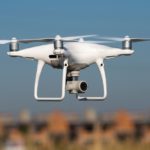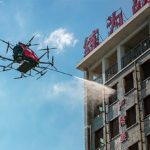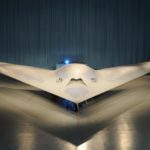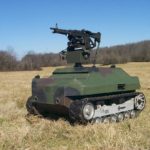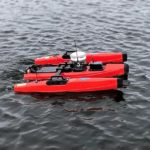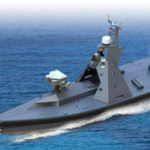There are virtually countless unmanned vehicles across Creation today, and thousands of models/variants, all of which you probably hear referred to as “drones”.
–
Table of Contents:
- Introduction
- Types
- History
- Example Images
–
Introduction:
An unmanned aerial vehicle (UAV), commonly known as a drone, is an aircraft without a human pilot aboard. UAVs are a component of an unmanned aircraft system (UAS); which include a UAV, a ground-based controller, and a system of communications between the two. The flight of UAVs may operate with various degrees of autonomy: either under remote control by a human operator or autonomously by onboard computers.
Compared to manned aircraft, UAVs were originally used for missions too “dull, dirty, or dangerous” for humans. While they originated mostly in military applications, their use is rapidly expanding to commercial, scientific, recreational, agricultural, and other applications, such as policing, peacekeeping, and surveillance, product deliveries, aerial photography, agriculture, smuggling, and drone racing. Civilian UAVs now vastly outnumber military UAVs, with estimates of over a million sold by 2015, so they can be seen as an early commercial application of autonomous things, to be followed by the autonomous car and home robots.
–
Types:
- UAV: Unmanned Aerial Vehicle
- USV: Unmanned Submersible Vehicle
- ULV: Unmanned Land Vehicle
–
History:
- In 1849 Austria sent unmanned, bomb-filled balloons to attack Venice. UAV innovations started in the early 1900s and originally focused on providing practice targets for training military personnel.
- UAV development continued during World War I, when the Dayton-Wright Airplane Company invented a pilotless aerial torpedo that would explode at a preset time.
- The earliest attempt at a powered UAV was A. M. Low‘s “Aerial Target” in 1916. Nikola Tesla described a fleet of unmanned aerial combat vehicles in 1915. Advances followed during and after World War I, including the Hewitt-Sperry Automatic Airplane. The first scaled remote piloted vehicle was developed by film star and model-airplane enthusiast Reginald Denny in 1935. More emerged during World War II – used both to train antiaircraft gunners and to fly attack missions. Nazi Germany produced and used various UAV aircraft during the war. Jet engines entered service after World War II in vehicles such as the Australian GAF Jindivik, and Teledyne Ryan Firebee I of 1951, while companies like Beechcraft offered their Model 1001 for the U.S. Navy in 1955. Nevertheless, they were little more than remote-controlled airplanes until the Vietnam War.
- In 1959, the U.S. Air Force, concerned about losing pilots over hostile territory, began planning for the use of unmanned aircraft. Planning intensified after the Soviet Union shot down a U-2 in 1960. Within days, a highly classified UAV program started under the code name of “Red Wagon”. The August 1964 clash in the Tonkin Gulf between naval units of the U.S. and North Vietnamese Navy initiated America’s highly classified UAVs (Ryan Model 147, Ryan AQM-91 Firefly, Lockheed D-21) into their first combat missions of the Vietnam War. When the Chinese government showed photographs of downed U.S. UAVs via Wide World Photos, the official U.S. response was “no comment”.
- The War of Attrition (1967–1970) featured the introduction of UAVs with reconnaissance cameras into combat in the Middle East.
- In the 1973 Yom Kippur War Israel used UAVs as decoys to spur opposing forces into wasting expensive anti-aircraft missiles.
- In 1973 the U.S. military officially confirmed that they had been using UAVs in Southeast Asia (Vietnam). Over 5,000 U.S. airmen had been killed and over 1,000 more were missing or captured. The USAF 100th Strategic Reconnaissance Wing flew about 3,435 UAV missions during the war at a cost of about 554 UAVs lost to all causes. In the words of USAF General George S. Brown, Commander, Air Force Systems Command, in 1972, “The only reason we need (UAVs) is that we don’t want to needlessly expend the man in the cockpit.” Later that year, General John C. Meyer, Commander in Chief, Strategic Air Command, stated, “we let the drone do the high-risk flying … the loss rate is high, but we are willing to risk more of them … they save lives!“
- During the 1973 Yom Kippur War, Soviet-supplied surface-to-air missile batteries in Egypt and Syria caused heavy damage to Israeli fighter jets. As a result, Israel developed the first UAV with real-time surveillance. The images and radar decoys provided by these UAVs helped Israel to completely neutralize the Syrian air defenses at the start of the 1982 Lebanon War, resulting in no pilots downed. The first time UAVs were used as proof-of-concept of super-agility post-stall controlled flight in combat-flight simulations involved tailless, stealth technology-based, three-dimensional thrust vectoring flight control, jet-steering UAVs in Israel in 1987.
- With the maturing and miniaturization of applicable technologies in the 1980s and 1990s, interest in UAVs grew within the higher echelons of the U.S. military. In the 1990s, the U.S. DoD gave a contract to AAI Corporation along with Israeli company Malat. The U.S. Navy bought the AAI Pioneer UAV that AAI and Malat developed jointly. Many of these UAVs saw service in the 1991 Gulf War. UAVs demonstrated the possibility of cheaper, more capable fighting machines, deployable without risk to aircrews. Initial generations primarily involved surveillance aircraft, but some carried armaments, such as the General Atomics MQ-1 Predator, that launched AGM-114 Hellfire air-to-ground missiles.
- CAPECON was a European Union project to develop UAVs, running from 1 May 2002 to 31 December 2005.
- As of 2012, the USAF employed 7,494 UAVs – almost one in three USAF aircraft. The Central Intelligence Agency also operated UAVs.
- In 2013 at least 50 countries used UAVs. China, Iran, Israel and others designed and built their own varieties
Further details here.
–
–
